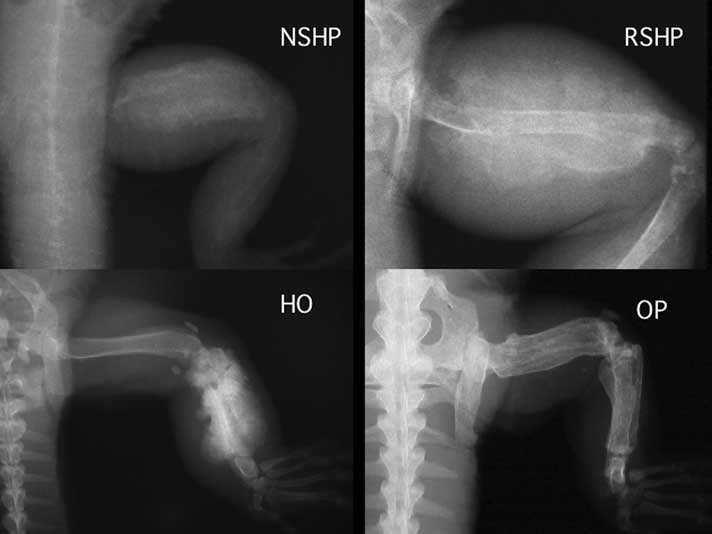MBD is not actually a single disease entity, it is a collection of medical disorders affecting the integrity and function of bones.
The term metabolic bone disease, also commonly referred to as MBD, has always been a pet peeve of mine, and I have been vocal about it many times over the years in my writings in REPTILES magazine. MBD is not actually a single disease entity, but rather a term used to describe a collection of medical disorders affecting the integrity and function of bones. Metabolic bone diseases (MBDs) are common in captive reptiles. There are many different MBDs that affect both animals and people. Most of what we know about MBDs in animals (including herps) comes from our knowledge in humans.

douglas mader, DVM
X-ray examples of four different types of MBD in lizards. Refer to the text for descriptions.
Historically, in the reptilian literature, any pathology affecting the bones of reptiles has been haphazardly called MBD. As the science of reptile medicine has progressed, more has been learned about the different diseases affecting the skeletal system. The following is a brief overview of several well-documented MBDs in green iguanas.
Nutritional Secondary Hyperparathyroidism (NSHP)
Metabolic bone disease (MBD) of nutritional origin (NMBD), which is the most common type of MBD that affects captive herpetofauna, is a consequence of dietary and husbandry mismanagement. Several factors combine to cause a prolonged deficiency of calcium and/or vitamin D, an imbalance of the calcium to phosphorus ratio in the diet, lack of exposure to direct, unfiltered natural sunlight or combinations thereof.
Nutritional secondary hyperparathyroidism (NSHP) is the technical name for NMBD commonly seen in captive iguanas. With NSHP, there is an excessive production of parathyroid hormone (PTH) from the parathyroid gland in response to hypocalcemia. Calcium is then resorbed from the bone. This results in a weakening of the bones.
The bones most commonly affected are the long bones (legs or ribs), the mandible (lower jaw), the flat bones of the skull, and lastly, the bones of the spine (vertebrae). You will commonly see thickened long bones, like the front or rear legs, spinal fractures and swollen jaws, giving the lizard a grotesque ‘smile’ appearance.
Renal Secondary Hyper-parathyroidism (RSHP)
Hyperphosphatemia is the hallmark of renal secondary hyperparathyroidism, a consequence of chronic renal disease. Phosphorus is absorbed from the gastrointestinal tract and eliminated via the kidneys. In renal failure, decreasing filtration rate leads to phosphorus retention and hyperphosphatemia.
The elevated phosphorus has a negative effect on calcium levels. In addition, the elevated phosphorus limits absorption of calcium from the intestinal tract. These changes result in low-normal or low-serum calcium levels, ultimately resulting in renal osteodystrophy, with bone changes similar to those seen with NSHP. This type of MBD can be referred to as RMBD to distinguish it from the NMBD.
Hypertrophic Osteopathy (HO)
Although not common in herps, HO has been reported in iguanas and other lizards. In mammals, HO is characterized by lameness, painful limbs and reluctance to move. Lung disease has been associated with this condition in greater than 90 percent of human cases.
X-ray changes consist of extensive new bone growth, beginning around the distal long bones, progressing. The cause is unknown, but theories include chronic poor appetite, toxins and complicated neurological pathways involving the vagus nerve.
In mammals, once HO has been diagnosed the condition is usually terminal. If an identifiable lung mass is found, surgical resection of the tumor may result in temporary resolution of the clinical signs, which may take several months to respond.
There are no reports of successful treatment in herps.
Osteopetrosis (OP)
This is a rare hereditary disease in humans where you see excessive thickening of the long bones. The bones become incredibly dense on X-rays, eventually obliterating the marrow cavity. The inciting cause is not known, but is believed to be an inability to resorb bone in a normal fashion. Given that the marrow cavity is destroyed, the patients become anemic (new red blood cells are made in the bone marrow). Nerve foramina in the skull become diminished, which can cause blindness and hearing impairments. The long bones become brittle and fracture easily.
Cases of osteopetrosis in reptiles in this author’s practice (unpublished), made by a radiological diagnosis only, have had similar clinical presentations. The cause of the condition in reptiles is unknown.
Want To Learn More?
Lizard Metabolic Bone Disease Duration
Five Popular Lizards And Five Medical Conditions Each May Experience
Summary
Why is this important? Because the treatments for all of these MBDs are markedly different. For instance, you treat NSHP with supplemental calcium (amongst other things). If you gave supplemental calcium to a patient with RSHP, you would definitely make the patient worse and potentially cause its demise.
So, to say, “my herp has MBD,” really doesn’t tell anyone what is wrong. I have been trying to change the use of this term over the years as follows:
When referring to NSHP, use the abbreviation NMBD.
When referring to RSHP, use the abbreviation RMBD.
Easy, huh? At least NMBD and RMBD reflect what is actually happening to the reptile and will not lead to confusion.
Douglas R. MADER, MS, DVM, DABVP (REPTILE/AMPHIBIAN), is a graduate of the University of California, Davis. He owns the Marathon Veterinary Hospital in the Conch Republic, and is a world-renowned lecturer, author and editor. He sits on the review boards of several scientific and veterinary journals.



